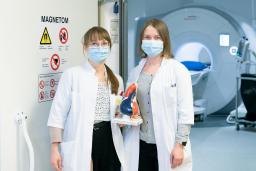MRI of cardiac patients brings new information in HUS studies
Keywords:HUS recently published two studies on MRI of cardiac patients. These studies have also at-tracted international interest.

Specializing Physician Aino-Maija Vuorinen and Radiologist Reetta Hälvä. Photo: Ville Männikkö, HUS
Usually, ultrasound is used to examine cardiac defects but different types of MRIs are becoming more common to obtain more detailed information about the heart’s function before a challenging cardiac operation, for example.
Aortic valve stenosis (AS) is the most significant valvular disease among the ageing population. When blood cannot flow forward from the heart as well as from a healthy valve, it causes various symptoms, such as dyspnoea and chest pain. The disease remains symptom-free for a long time, and the patient is generally unaware of the problem. But when the symptoms start to appear, the disease is usually severe.
“Stenosis causes changes in the myocardium, and some of them are permanent. The general treatment is a valve operation performed as an open heart surgery. Transcatheter aortic valve implantation (TAVI) can be used for some patients to implant a prosthetic heart valve. Untreated, valvular disease leads to death because the patient’s heart will give up at some point as the stenosis progresses”, says radiologist Reetta Hälvä from the HUS Diagnostic Center.
Emerging four-dimensional (4D) MRI technique enables 3D evaluation of flow conditions in the aorta. This technique is expected to bring more detailed information about aortic flow conditions in patients with severe AS.
“When we compared the results from 4D flow technique with results from 2D technique and ultrasound of the heart, we realised that the 4D technique underestimated peak flow in the aorta and is not suitable for diagnosing patients with severe AS”, says Hälvä.
The study showed that 2D velocity encoded MRI can be used to assess the severity of the disease in patients with AS when ultrasound cannot be used. However, the 4D technique was superior in healthy individuals.
The study has been published in the Journal of Cardiovascular Magnetic Resonance.
Epicardial pacing leads do not always prevent MRI
Due to the heating of pacemaker leads, international clinical guidelines do not recommend MRI for patients with a pacemaker and epicardial pacing leads attached to surface of the heart in an open heart surgery. Epicardial pacing leads are used especially in pediatric patients and patients with a congenital heart disease.
Based on individual assessment, HUS has performed MRI on adult patients with epicardial pacing leads when the benefits of MRI have been considered to outweigh the possible risks. The pacemaker must always be adjusted before an MRI.
“In our study, no adverse events were detected in MRIs performed on patients with modern, functioning epicardial leads”, says specializing physician Aino-Maija Vuorinen.
Compared to ultrasound, an MRI is often a better way of assessing the heart function and performing various measurements–such as the amount of blood pumped by the heart, the amount of blood flow in different veins or the amount of scar tissue in the myocardium.
“If the patient has undergone several surgeries or has abnormal anatomy, MRI can be very useful. MRI is particularly important when considering heart transplantation and assessing if a valve operation or another operation could improve the situation“, says Vuorinen.
Based on this study and other publications on the same topic, HUS has decided to perform MRI also in pediatric patients with epicardial pacing leads, provided that certain conditions are met.
The study has been published in the European Radiology journal.